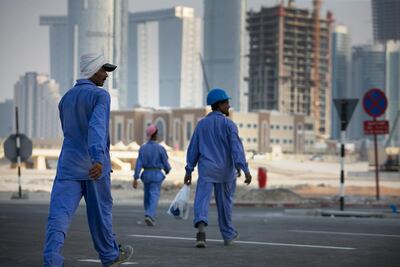A surge in the numbers of working women, higher unemployment rates among UAE citizens and the continuing conundrum of how to make the private sector attractive to nationals are highlights of the labour segment of the wide-ranging UAE Human Development Report.
As the second largest Arab economy after Saudi Arabia, the report recommends that the UAE handle challenges in unemployment with focused training of nationals and strengthening links between the education sector and industry.
Unemployment rates among Emirati citizens had risen to more than 13 per cent in 2013 – about 41,000 people – from about 1,900 people, or 4 per cent, in 1975. Of the unemployed, 62 per cent are women and the majority – 64 per cent – without jobs are in the youth bracket up to 29 years.
“It is clear that education plays a leading role in reducing unemployment in the country,” the report stated. This was backed by research that showed high numbers of unemployed men and women in the youth and adult, or 30-plus age category, had studied up to secondary school or below.
The percentage system or quotas to boost Emiratisation in the private sector, such as in banks and insurance companies, has met with some success. But the main challenge was that “Emirati citizens still prefer working in the government sector given the big difference in salaries between the two sectors, the benefits, work conditions, promotions and occupational stability”, the report noted.
Taxes for employing migrant workers in positions that can be filled by Emiratis or subsidising salaries of UAE nationals working in the private sector are among suggestions to increase employment figures.
The preference for public sector jobs is reflected in the numbers, which show that 77 per cent of working Emiratis are in public, federal and local organisations; 17 per cent work in the joint sector, which provides nearly the same advantages as that of the public sector; while nationals in the private sector make up only 6 per cent.
“The authorities must also carry out regular surveys on the unemployed so as to identify their characteristics and therefore implement appropriate strategies to deal with the issue,” the report said.
Overall, owing to the construction of mega infrastructure projects, the flow of foreign migrant workers shot up to 6 million in 2015 from about 250,000 in 1975, an average growth of about 8 per cent.
The national labour force grew to about 342,000 by the end 2015 compared with 45,000 in 1975, an average growth of 5.1 per cent.
_______________
Read more:
Emirati Women's Day: Hire more women, say recruiters
Let failing Emirati pupils fail so they may eventually succeed, say education experts
Private sector looks to Emiratis for senior positions and not just admin roles
Fewer Indian migrants seeking work in the UAE and Gulf, study preview suggests
_______________
The country’s total labour force rose from about 300,000 in 1975 to more than 6.4 million in 2015, posting average growth of about 7.7 per cent.
The report also charts the soaring figures of Emirati women in the workplace, from 1,000 in 1975 to about 135,000 in 2015 – an increase of 135 times in four decades. The figures for men show only a five-fold increase, from 44,000 in 1975 to about 207,000 in 2015.
Among factors that have contributed to the rise of women in employment are access to education and society’s acceptance of working women.
Another characteristic of the UAE’s labour market is that women have higher educational levels, both among citizens and migrants. The percentage of women with a bachelor’s degree touches 43 per cent as against 23 per cent for men.
In the sector-wise break-up, the construction industry employs a third of workers in the private sector at 33 per cent, followed by the commercial sector at 24 per cent, real estate at 11 per cent and the manufacturing industry at 10 per cent.

Big numbers of migrant workers sending home money places the UAE third globally in terms of remittance outflows after Saudi Arabia and the United States. Remittances from the UAE reached US$32.5 billion (Dh119.3bn) in 2015 with India leading the nations to which money is transferred, followed by Pakistan and the Philippines. In the Arab world, Egypt heads the list of countries to which money is remitted by migrant workers, followed by Jordan.
Looking ahead, the report underlines that the number of skilled workers must increase with plans to shift gear to a knowledge-based economy to meet targets of innovation, economic and human development.
“It is of the utmost important to employ optimally the national labour force in the strategic sectors and activities that have a high productivity and a strong impact on the future economic development. It is also important to encourage women’s participation in the labour market,” the report said.


